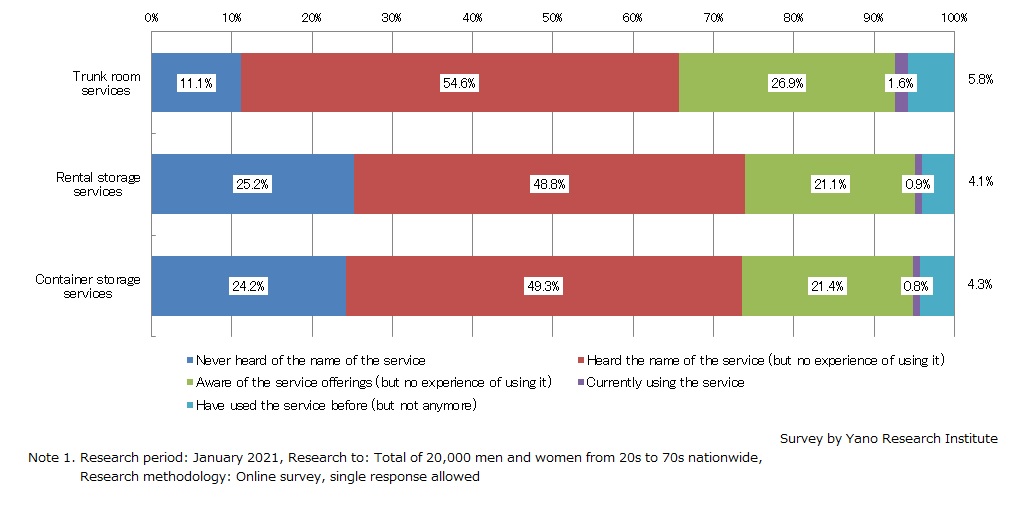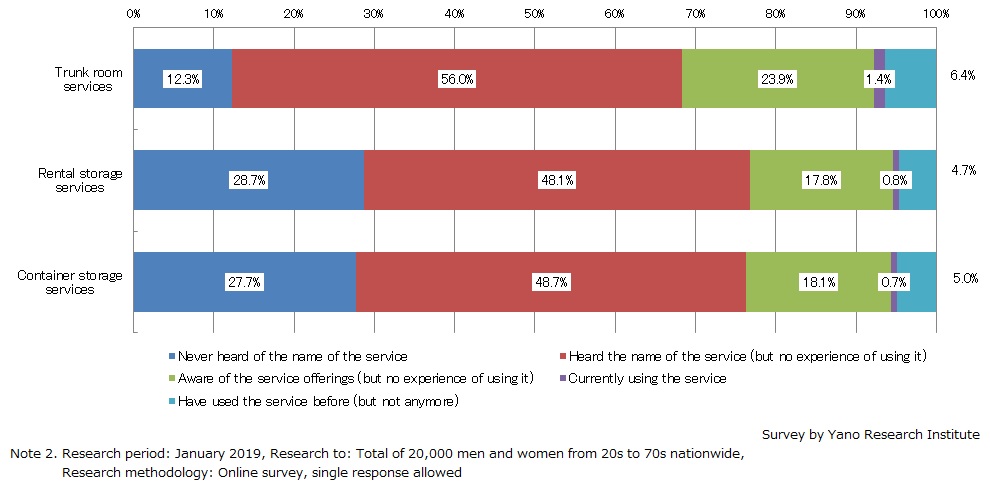No.2723
Consumer Survey on Storage Services in Japan: Key Research Findings 2021
January 2021 Consumer Survey on Storage Services Finds Increase of Percentage Points in Consumer Visibility Compared to 2019 Survey
Yano Research Institute (the President, Takashi Mizukoshi) has carried out a consumer survey on the domestic market of storage services. This survey is targeted to users and prospective users of storage services, and is analyzed comparatively to the results from same survey done in the past. Here, the consumer visibility and the use status of storage services are announced.


Summary of Research Findings
The consumer survey about the use of storage service was carried out to 20,000 men and women with the age ranges between 20s and 70s nationwide. It aims to explore use status of storage services (i.e. visibility/perception, current/past user experience, interest toward use of storage service, criteria for choosing the service, good points/bad points of storage service, reasons for ending the use of service, and changes in usage).
A ratio of respondents that have experience of using the storage service (a total of “currently using the service” and “have used the service before (but not anymore)”) was 7.4% for “trunk room service”, 5.0% for “rental storage service” and 5.1% for “container storage service”. Since the percentages were 7.8%, 5.5%, and 5.7% respectively, in the last survey conducted in January 2019, the results indicate that the ratio of users in 2021 stayed at almost the same level as in 2019.
On the other hand, a ratio of consumers not aware of the storage services (a percentage of those who responded “never heard of the name of the service”) were 11.1% for “trunk room”, 25.2% for “rental storage service”, and 24.2% for “container storage service. In the previous survey conducted in January 2019, the percentages were 12.3%, 28.7%, and 27.7%, respectively; a moderate increase is witnessed in the percentage points for visibility of each of the storage services. While the ratio of storage service users has stayed almost flat, a percentage of those ‘not’ aware of the service have decreased; the survey finds the rise of consumer visibility for the storage services.
Noteworthy Topics
Demand for Decluttering
One of the factors that trigger the use of the storage service is “decluttering”. Meanwhile, as a way to “declutter”, options include not only “put in storage” but also “get rid of”. Along with this research, an additional survey was carried out to 300 men and women who are aware of the storage service but have no experience using it, to find out their intention of using the storage services in the future. To a question asking what kind of facility or function they want for storage spaces, many responded that they want a service to get rid of, or sell, their clutters.
Indeed, use of the storage service would help organizing items occupying user’s space. However, the survey results suggest that, in addition to “decluttering”, expanding “get rid of” services for clutters would improve the convenience of storage service users.
Research Outline
2.Research Object: General consumers in their ages between 20s and 70s nationwide
3.Research Methogology: Online consumer survey (questionnaire)
Storage Services
The consumer survey about the use of storage service, which has become one of the daily life assisting services for general consumers, was carried out to 20,000 men and women with the age ranges between 20s and 70s nationwide. It aims to explore use status of storage services (i.e. visibility/perception, current/past user experience, interest toward use of storage service, criteria for choosing the service, good points/bad points of storage service, reasons for ending the use of service, and changes in usage).
At the same time, a questionnaire survey was carried out to 300 men and women who is aware of the storage services but has no experience using it, about their intention to use the service in the future (reasons for not using the service, timing for considering the use, storage-unit size, storage-rental rates, acceptable range of distance to/facility and function demanded for storage service location, and items to be stored in the storage space).
The storage service in this survey is defined as the business providing chargeable storage for personal property (basically those without any purpose to sell) outside of the office or home. They are categorized into the following three types: 1) Rental storage services, 2) container storage services, and 3) trunk room services.
1) Rental storage services are operated mainly by real estate agencies to lend indoor rooms and spaces, including those in storing-only buildings where individuals or corporate bodies can store things. Nevertheless, safe-deposit boxes operated by banks and baggage lockers located at places such as railway stations are not included.
2) Container storage services are similar to rental storage services, only that those rooms and spaces provided are not placed indoors but outdoor containers or the storage made of steel*.
3) Trunk room services are operated chiefly by warehouse companies, which provide trunk rooms certified by MLIT (Ministry of Land, Infrastructure, Transport and Tourism) in which luggage and furniture of individuals can be deposited (limited to the use by the habitants, and therefore, storage of documents and the use by corporate bodies are not included.)
*Translator’s note: The storage made of steel refers to something similar to a marine or shipping container.
<Products and Services in the Market>
Rental storage, container storage and trunk room
Published Report
Contact Us
The copyright and all other rights pertaining to this report belong to Yano Research Institute.
Please contact our PR team when quoting the report contents for the purpose other than media coverage.
Depending on the purpose of using our report, we may ask you to present your sentences for confirmation beforehand.